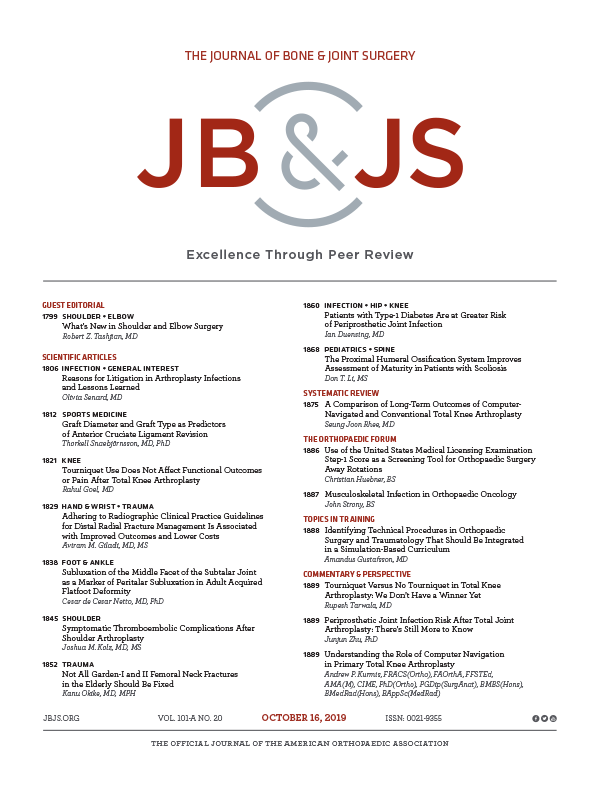
Comparable outcomes with autologous chondrocyte implantation and microfracture surgery

Comparable outcomes with autologous chondrocyte implantation and microfracture surgery
A Randomized Trial Comparing Autologous Chondrocyte Implantation with Microfracture: Findings at Five Years
J Bone Joint Surg Am. 2007 Oct;89(10):2105-12Did you know you're eligible to earn 0.5 CME credits for reading this report? Click Here
Synopsis
This study was based on previous work completed by the same authors in 2004 which looked at the outcomes of autologous chondrocyte implantation and microfracture surgery at 2-year follow-up. This current study looks at outcomes at 5-year follow-up. 80 patients with a single chronic symptomatic cartilage defect on the femoral condyle were randomized to undergo one of two treatments. One group underwent an autologous chondrocyte implantation procedure while the other group underwent microfracture surgery. Results showed that clinical outcomes were comparable between the two groups. One-third of the patients showed radiographic signs of early osteoarthritis at the 5-year follow-up.
Was the allocation sequence adequately generated?
Was allocation adequately concealed?
Blinding Treatment Providers: Was knowledge of the allocated interventions adequately prevented?
Blinding Outcome Assessors: Was knowledge of the allocated interventions adequately prevented?
Blinding Patients: Was knowledge of the allocated interventions adequately prevented?
Was loss to follow-up (missing outcome data) infrequent?
Are reports of the study free of suggestion of selective outcome reporting?
Were outcomes objective, patient-important and assessed in a manner to limit bias (ie. duplicate assessors, Independent assessors)?
Was the sample size sufficiently large to assure a balance of prognosis and sufficiently large number of outcome events?
Was investigator expertise/experience with both treatment and control techniques likely the same (ie.were criteria for surgeon participation/expertise provided)?
Yes = 1
Uncertain = 0.5
Not Relevant = 0
No = 0
The Reporting Criteria Assessment evaluates the transparency with which authors report the methodological and trial characteristics of the trial within the publication. The assessment is divided into five categories which are presented below.
1/4
Randomization
3/4
Outcome Measurements
1/4
Inclusion / Exclusion
2/4
Therapy Description
4/4
Statistics
Detsky AS, Naylor CD, O'Rourke K, McGeer AJ, L'Abbé KA. J Clin Epidemiol. 1992;45:255-65
The Fragility Index is a tool that aids in the interpretation of significant findings, providing a measure of strength for a result. The Fragility Index represents the number of consecutive events that need to be added to a dichotomous outcome to make the finding no longer significant. A small number represents a weaker finding and a large number represents a stronger finding.
Why was this study needed now?
Autologous chondrocyte implantation and microfracture surgery are two procedures used in the treatment of cartilage lesions, but there is uncertainty on what is the best method for treatment. In 2004, the authors of this current study presented the results of these two methods of treatment at the 2-year follow-up. This study examines autologous chondrocyte implantation compared to microfracture surgery in the treatment of cartilage lesions at the 5-year follow-up.
What was the principal research question?
What are the clinical outcomes of performing autologous chondrocyte implantation compared to microfracture procedure on patients with a single chronic symptomatic cartilage defect on the femoral condyle at the 5-year follow-up?
What were the important findings?
- There were no significant differences seen between the two groups on the Lysholm score (p=0.227) and the VAS scores (p=0.278) at the 5-year follow-up.
- Both the implantation and microfracture group saw clinically significant improvements from preoperative measures at the 2 and 5-year follow-up.
- 72% of the patients in both groups saw an improvement in pain and 80% of the patients had better Lysholm scores from baseline at the 5-year follow-up. (p<0.05)
- At the 5-year follow-up, both groups saw 9 failures (23%) compared to the 2-year follow-up where the implantation group saw 2 failures and the microfracture group saw 1.
- Patients with the best-quality cartilage (mainly hyaline) examined at the 2-year follow up did not have any subsequent failures.
- No correlation was seen with histological quality and clinical outcomes.
- At the 5-year follow-up, 1/3 of the patients in each group showed radiographic evidence of early osteoarthritis.
What should I remember most?
No significant differences were seen in clinical and radiographic outcomes between the autologous chondrocyte implantation group and the microfracture group at follow-up. 77% of patients in both groups saw satisfactory results. At the 5-year follow-up, 1/3 of the patients saw early radiographic signs of osteoarthritis. The study also proposed that microfracture surgery should be the first option for treatment due to it's minimally invasive and low-cost factors.
How will this affect the care of my patients?
Patients may not find any significant differences when undergoing autologous chondrocyte implantation or microfracture procedure in the treatment of cartilage lesions. Further studies are required to determine the long-term effects of both treatments as well as the progression of osteoarthritis.
Learn about our AI Driven
High Impact Search Feature
Our AI driven High Impact metric calculates the impact an article will have by considering both the publishing journal and the content of the article itself. Built using the latest advances in natural language processing, OE High Impact predicts an article’s future number of citations better than impact factor alone.
Continue



 LOGIN
LOGIN

Join the Conversation
Please Login or Join to leave comments.